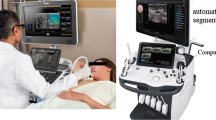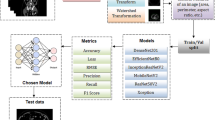Abstract
In this paper, a novel approach is proposed to detect the dental materials in dental Panoramic images. In general, dental Panoramic images are examined by the dentists to detect the dental materials of the patients. Examining the dental Panoramic images is a time-consuming procedure and necessitates highly skilled dentists. Thus, computer imaging and decision support systems based on machine learning are in demand for dental applications. In this study, a semi-automatic, image processing and machine learning based approach is proposed for detection of dental materials in dental Panoramic images. More specifically, the dental materials namely dental filling, dental bridge and tooth crown are targeted by the proposed approach. Within the approach developed, the dental Panoramic images used as input are initially pre-processed for noise removal and tooth region is determined using a deep learning approach. To this end, a faster Regional Convolutional Neural Networks (RCNN) method is employed. A tooth region correction procedure is applied after application of faster RCNN to determine the exact location of the tooth region as faster RCNN may produce more tooth regions than one correct tooth region. Graph cut (GC) based image segmentation is applied to segment the tooth region into foreground and background regions. Shape based feature extraction and classification are applied to determine the tooth problem. A dataset has been established in dental faculty hospital of private dental clinics. The proposed approach is simple yet quite effective. In all classification methods, the average accuracy scores were around 90%.















Similar content being viewed by others
References
Johnson WW (1959) The history of prosthetic dentistry. J Prosthet Dent 9(5):841–846
Petersen PE (2003) The World Oral Health Report 2003: continuous improvement of oral health in the 21st century–the approach of the WHO Global Oral Health Programme. Commun Dent Oral Epidemiol 31:3–24
Chaushu S, Chaushu G, Becker A (1999) The use of panoramic radiographs to localize displaced maxillary canines. Oral Surg Oral Med Oral Radiol Endod 88(4):511–516
Gratt BM (2003) Panoramic radiography. In: Stuart C. White, Michael J. Pharoah, Donald O'Connor. Oral Radiology: Principles and Interpretation, (5th ed) Elsevier Science 2003; 191–210.
Mattick CR, Carter NE, Gordon PH (1999) The diagnostic value of routine intra-oral premaxillary radiographs in orthodontic assessment. Int J Paediatr Dent 9(3):161–168
Yamashita R, Nishio M, Do RKG, Togashi K (2018) Convolutional neural networks: an overview and application in radiology. Insights Img 9:611–629
Gao XW, Hui R, Tian Z (2017) Classification of CT brain images based on deep learning networks. Comput Methods Progr Biomed 138:49–56
Turkoglu M (2020) COVIDetectioNet: COVID-19 diagnosis system based on X-ray images using features selected from pre-learned deep features ensemble. Applied Intelligence, 1–14.
Toğaçar M, Cömert Z, Ergen B (2020) Classification of brain MRI using hyper column technique with convolutional neural network and feature selection method. Expert Syst Appl 149:113274
Yasaka K, Akai H, Abe O, Kiryu S (2018) Deep learning with convolutional neural network for differentiation of liver masses at dynamic contrast-enhanced CT: a preliminary study. Radiology 286(3):887–896
Şengür D (2020) Investigation of the relationships of the students’ academic level and gender with Covid-19 based anxiety and protective behaviors: A data mining approach. Turkish J Sci Technol 15(2):93–99
Ismael AM, Şengür A (2020) Deep learning approaches for COVID-19 detection based on chest X-ray images. Expert Syst Appl 164:114054
Lakshmi MM, Chitra P (2020) Classification of Dental Cavities from X-ray images using Deep CNN algorithm. In: 2020 4th International Conference on Trends in Electronics and Informatics (ICOEI), 774–779
Virupaiah G, Sathyanarayana AK (2020) Analysis of image enhancement techniques for dental caries detection using texture analysis and support vector machine. Int J Appl Sci Eng 17(1):75–86
Zhao Y, Li P, Gao C, Liu Y, Chen Q, Yang F, Meng D (2020) TSASNet: Tooth segmentation on dental panoramic X-ray images by two-stage attention segmentation network. Knowl Based Syst 206:106338
Sukegawa S et al (2020) Deep neural networks for dental implant system classification. Biomolecules 10(7):984
Laishram A, Thongam K (2020) Detection and Classification of Dental Pathologies using Faster-RCNN in Orthopantomogram Radiography Image. In: 2020 7th International Conference on Signal Processing and Integrated Networks (SPIN), pp 423–428
Al Kheraif AA, Wahba AA, Fouad H (2019) Detection of dental diseases from radiographic 2d dental image using hybrid graph-cut technique and convolutional neural network. Measurement 146:333–342
Hasan MM, Ismail W, Hassan R, Yoshitaka A (2016) Automatic segmentation of jaw from panoramic dental X-ray images using GVF snakes. In: 2016 World Automation Congress (WAC), pp 1–6
Said EH, Nassar DEM, Fahmy G, Ammar HH (2006) Teeth segmentation in digitized dental X-ray films using mathematical morphology. IEEE Trans Inf Forensics Secur 1(2):178–189
Banu AFS, Kayalvizhi M, Arumugam B, Gurunathan U (2014) Texture based classification of dental cysts. 2014 In: International Conference on Control, Instrumentation, Communication and Computational Technologies (ICCICCT), pp 1248–1253
Ahmad SA, Taib MN, Khalid NEA, Ahmad R, Taib H (2011) Performance of compound enhancement algorithms on dental radiograph images. Word Academy of science, Engineering and Technology, 668–669
Lee JH, Han SS, Kim YH, Lee C, Kim I (2020) Application of a fully deep convolutional neural network to the automation of tooth segmentation on panoramic radiographs. Oral Surg Oral Med Oral Pathol Oral Radiol 129(6):635–642
Tian J, Hu J (2019) Image target detection based on deep convolutional neural network. In: 2019 International conference on communications, information system and computer engineering (CISCE), pp 461–464
Li X, He M, Li H, Shen H (2021) A Combined Loss-based Multiscale Fully Convolutional Network for High-resolution Remote Sensing Image Change Detection. IEEE Geosci. Remote Sens. Lett. pp 1–5
Zhu H, Zhang Q, Wang Q (2017) 4D light field superpixel and segmentation. In: Proceedings of the IEEE conference on computer vision and pattern recognition, pp 6384–6392
**ao Y, Zijie Z (2020) Infrared image extraction algorithm based on adaptive growth immune field. Neural Process Lett 51(3):2575–2587
Liu X et al (2019) Multiple kernel k-Means with incomplete kernels. IEEE Trans Pattern Anal Mach Intell 42(5):1191–1204
Yu X, Lu Y, Gao Q (2021) Pipeline image diagnosis algorithm based on neural immune ensemble learning. Int J Pressure Vessels Pip 189:104249
Girshick R, Donahue J, Darrell T, Malik J (2014) Rich feature hierarchies for accurate object detection and semantic segmentation. In: Proceedings of the IEEE conference on computer vision and pattern recognition, pp 580–587
Girshick R (2015) Fast r-cnn. In: Proceedings of the IEEE international conference on computer vision, pp 1440–1448
Ren S, He K, Girshick R, Sun J (2016) Faster r-cnn: towards real-time object detection with region proposal networks. IEEE Trans Pattern Anal Mach Intell 39(6):1137–1149
Peng B, Zhang L, Zhang D (2013) A survey of graph theoretical approaches to image segmentation. Pattern Recogn 46(3):1020–1038
Greig DM, Porteous BT, Seheult AH (1989) Exact maximum a posteriori estimation for binary images. J Roy Stat Soc: Ser B (Methodol) 51(2):271–279
Boykov Y, Funka-Lea G (2006) Graph cuts and efficient ND image segmentation. Int J Comput Vision 70(2):109–131
Le TH, Jung SW, Choi KS, Ko SJ (2010) Image segmentation based on modified graph-cut algorithm. Electron Lett 46(16):1121–1123
Yi F, Moon I (2012) Image segmentation: A survey of graph-cut methods. In 2012 International Conference on Systems and Informatics (ICSAI2012), 1936–1941.
Cortes C, Vapnik V (1995) Support-vector networks. Mach Learn 20(3):273–297
Osowski S, Siwek K, Markiewicz T (2004) Mlp and svm networks-a comparative study, in Proceedings of the 6th Nordic Signal Processing Symposium, NORSIG, 37–40.
Rasjid ZE, Setiawan R (2017) Performance comparison and optimization of text document classification using k-nn and naïve bayes classification techniques. Procedia Comput Sci 116:107–112
Ala’raj M, Majdalawieh M, Abbod MF (2020) Improving binary classification using filtering based on k-NN proximity graphs. J Big Data 7(1):1–18
Sharmila A, Geethanjali P (2016) DWT based detection of epileptic seizure from EEG signals using naive bayes and k-NN classifiers. IEEE Access 4:7716–7727
Funding
Thanks are owed to the Small and Medium Enterprises Development Organization of Turkey (KOSGEB) which supported the current study under R&D and Innovation Support Programme project number 62146, “Artificial intelligence-based expert system design in oral radiological imaging techniques.”
Author information
Authors and Affiliations
Contributions
Andaç Imak: Data curation, Formal analysis, Resources, Writing – original draft. Adalet Çelebi: Investigation, Visualization, Data analysis. Muammer Turkoglu: Methodology, Software, Visualization, Writing- review & editing. Abdulkadir Şengür: Conceptualization, Methodology, Writingreview & editing.
Corresponding author
Ethics declarations
Conflict of interest
All authors of the manuscript declare that they have no conflict of interest in publishing this research work.
Ethical Approval
Prior to the study, an approval was obtained from Firat University Noninterventional Clinical Research Ethics Committee (Approval Date: December 31, 2020; No: 2020/17–15).
Informed Consent
Informed consent was obtained from all individual participants included in the study.
Additional information
Publisher's Note
Springer Nature remains neutral with regard to jurisdictional claims in published maps and institutional affiliations.
Rights and permissions
About this article
Cite this article
Imak, A., Çelebi, A., Türkoğlu, M. et al. Dental Material Detection based on Faster Regional Convolutional Neural Networks and Shape Features. Neural Process Lett 54, 2107–2126 (2022). https://doi.org/10.1007/s11063-021-10721-5
Accepted:
Published:
Issue Date:
DOI: https://doi.org/10.1007/s11063-021-10721-5




